Black and White Duck Breed Guide
Most of us are familiar with the intricate color patterns of the Mallard duck and with the quintessential white farm duck (like the Pekin), but there are many other color combinations in the duck world that the average person may know about. One particularly striking color combination is the classic black and white duck. There are a handful of black and white duck breeds – some of them are productive layers, some boast flavorful meat, and all of them will add beauty to your backyard flock.
Which breeds of duck are black and white? There are several black and white domestic duck breeds. The ten most commonly seen black and white ducks are:
- Black Swedish
- Magpie
- Muscovy
- Ancona
- Pomeranian
- Crested
- Cayuga
- Black Runner
- Call Duck
- Duclair
Black and White Ducks
Black Swedish Ducks 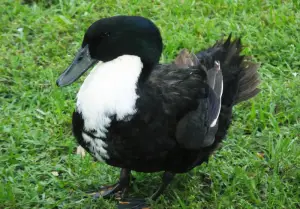
One of the most recognizable black and white duck breeds is the Black Swedish. This duck sports bluish-black feathers on the head and body with white chests. Many theorize that Daffy Duck himself belongs to the Black Swedish breed. Black Swedish ducks are medium-sized birds and are kept for both eggs and meat. They mature quickly and are known to lay between 130 and 180 eggs per year.
The Black Swedish is a variant of the Blue Swedish, a popular ornamental and dual-purpose breed. Blue Swedish ducks have the same markings as the Black Swedish, but instead of the black body feathers, they will have grayish-blue feathers. They are striking birds and are popular in exhibitions. By breeding a Black Swedish to a Splashed, many of the offspring will be Blue Swedish birds. Mating two Black Swedish ducks to one another will result in Black Swedish offspring.
Magpie Ducks 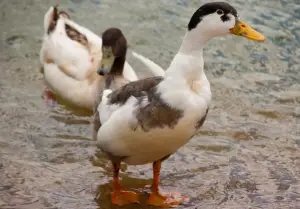
Magpie ducks are white ducks with distinct dark markings on the top of the head (called their “caps”), above the eyes, and on the tails and wings. These markings can be either a dark charcoal black or a light gray. As the Magpie ages, the dark patches will gain more white feathers with each molt until the bird is entirely white in color.
Magpies are light-framed birds and, despite their smaller carcasses, offer flavorful and desirable meat. Where they really shine is in their egg production – Magpies can lay as many as 290 eggs per year. Magpies are great foragers and would make an excellent addition to most homesteads.
Muscovy Ducks 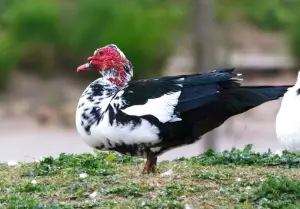
The Muscovy is the only breed of domestic duck that cannot trace its roots back to the Mallard. In fact, if you breed a Muscovy to any other domestic duck, the resulting offspring will be infertile and called a “mule duck” since the Muscovy and the Mallard are two separate species.
Muscovies are very popular farm ducks and excellent producers of meat – in France, 90% of duck meat comes from the Muscovy. They are large ducks and are known for their quiet presence – female Muscovies do not quack like females of the Mallard species.
Muscovies are recognizable for their red, fleshy “masks” that cover the faces from the bill to the eyes. This mask is called the duck’s caruncles. The most readily available variety of Muscovy is usually all white in color, called the “White Muscovy,” but will frequently present with a black “cap” on the top of the head. Other varieties of Muscovy are white with large black patches.
Ancona Ducks 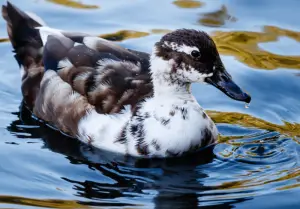
Anconas are medium-sized ducks bred for both their egg production (laying as many as 280 eggs per year) and their high-quality meat. They are harder to find than some of the ducks on this list, but recent conservation efforts have seen the Ancona breeding stock increase to levels allowing the American Livestock Breeds Conservancy to move them from “critically endangered” to the watch list in the last few years.
Ancona ducks are black and white, though white ducks with patches of other colors are also accepted. They are known for their unique “broken color” patterns on their bellies, heads, sides, and backs.
Pomeranian Ducks 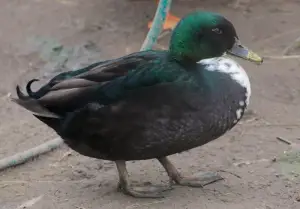
Pomeranian ducks are black in color with white bibs, black legs, and a black bill. They are attractive medium-sized birds and are average layers – producing approximately 80-100 eggs per year. Pomeranian ducks are not commonly found in the United States and are often kept for ornamental purposes.
Of note, Pomeranians are known as “guard ducks” – these birds will famously announce visitors with loud quacking. This can be a positive if you would like to be alerted when someone is approaching but can be a negative if you are looking for a quieter yard.
Crested Ducks 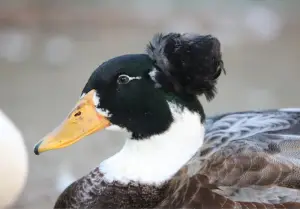
Crested ducks are best known for the puffs (or crests) on the top of the head. They are kept for ornamental purposes and make great pets, being friendly and docile. Crested ducks come in a variety of colors, including black, white, and black and white. They are quick growing and lay around 100-130 cream-colored eggs per year.
Traditionally, Crested ducks have been challenging to breed. The crests, while adorable, are technically deformities of the skull – to successfully breed them, you must breed a Crested duck with a non-crested duck.
In this scenario, 25% of the eggs will fail to hatch, 25% will not have crests, and 50% will be crested ducklings. In recent years, some hatcheries and breeders have claimed to be able to breed Crested ducks with more accuracy and success, however.
Cayuga Ducks 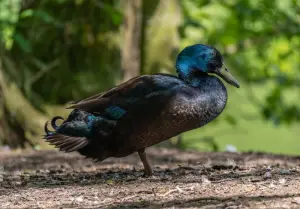
Cayuga ducks are a beautiful black in color with black legs and a black bill. While the drakes will keep these black feathers, with age, the females will grow more white feathers with each molt, giving them a mottled black-and-white pattern as they reach middle age. These white feathers will often increase with each molt until the female is all-white in color in her old age.
Interestingly, the eggs of the Cayuga will progress in color as the feathers of the ducks themselves. At the beginning of each season, Cayugas will lay eggs in a black or dark-gray color. As the season progresses, the eggs will gradually lighten in color until they are almost white as Fall approaches. These egg changes are unique to Cayuga ducks – most egg layers will lay eggs of the same color throughout the season.
Cayugas are friendly and hardy birds. They tolerate Northern winters and make excellent foragers. The majority of the Cayuga’s diet can come from forage so long as she has adequate space to roam.
Black Runner Ducks 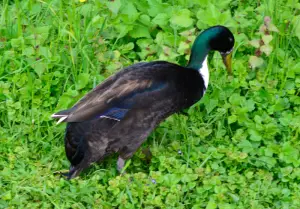
The Black Runner is a variety of the Indian Runner Duck – commonly kept as backyard ducks for their excellent egg production (around 300 eggs per year) and pest control. Indian Runners are unique in body shape, having earned the nickname of “bowling pins on legs.” They have an upright posture and take high, quick steps as opposed to the classic duck waddle. Indian Runners tend to be nervous by nature, sticking close to one another to feel safe.
The Black Runner is all-black in color, but Indian Runners come in a variety of other colors as well – from brown to fawn and white, white, and gray-blue. Though a true black-and-white Indian Runner is not common, having a flock of Indian Runners and Black Runners together will give you a variety of color contrasts (and a whole lot of eggs).
Call Ducks 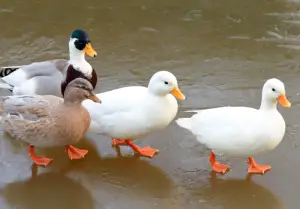
Call Ducks are the smallest of the domesticated breeds, though certainly not the quietest – the females are known to be very loud and frequent quackers, having been bred for their impressive “calls” to use as duck decoys by hunters. Call Ducks are not very productive and are rather kept as pets or for 4H. They are easy to handle, docile, and quite friendly. Call Ducks are known to be interactive and great with children.
Call Ducks are commonly found in black or gray with white bibs, though they can also be found in all-black, all-blue, all-white, “pastel”, white-gray, and Mallard-like patterns and coloring.
Duclair Ducks 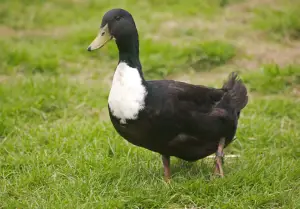
The Duclair is an older breed from France, though has recently become more readily available through specific hatcheries in the US. They are prized for their flavorful meat but can also produce as many as 150 green-tinted eggs per year.
Duclairs are most commonly found in a black or blue color with a white bib and white wing tips. The females have a black head, while the male’s head will be green. Duclairs also come in an all-white variety, aptly called the White Duclair.
Which Black And White Duck Is For You?
There are several productive, friendly duck breeds with striking black-and-white feather patterns. You can find an attractive bird whether you are looking for egg production, meat, or as an exhibition or pet bird. Many, if not all, of the birds listed above can be found through an online hatchery, and you may even be able to order a few of each for a really distinctive flock.
